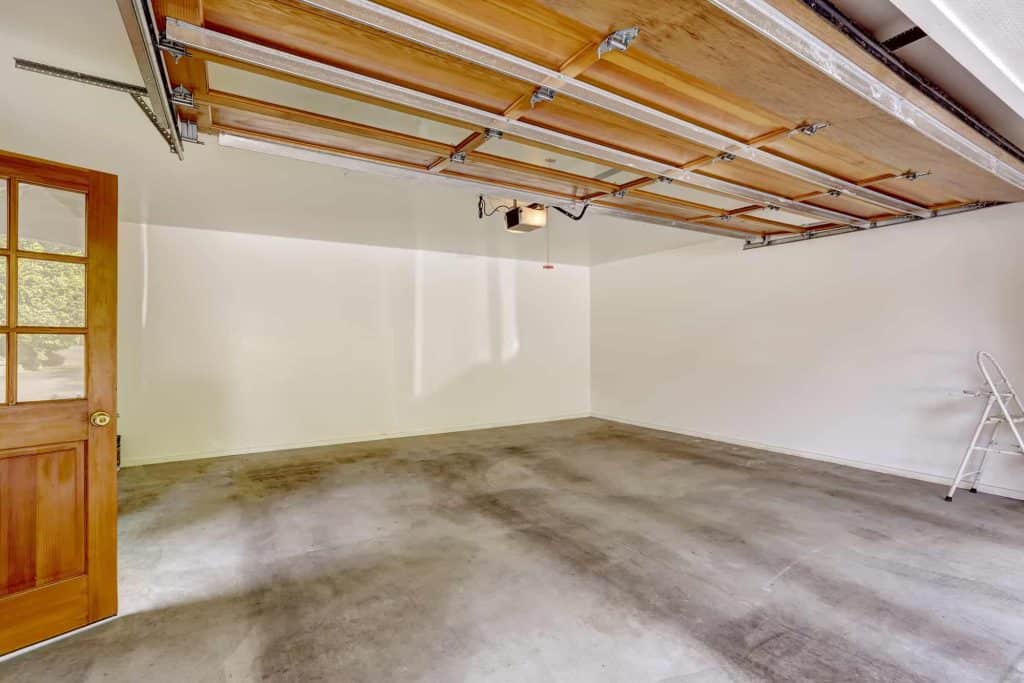Many people choose to have exposed concrete floors around the home, from the garage to living spaces. Such floors are easy to clean and can look great when stained or painted. However, preparing the surface for paint or epoxy often involves sanding and sealing. How is this achieved?
To sand and seal a concrete floor easily, choose handheld concrete sanders or more industrial variants with wheels for easy pushing around the area. These tools are equipped with diamond-tipped sanding discs to withstand the strain from the surface.
In this article, we’ll cover all you need to know about sanding and sealing concrete floors. Watch out for tips on how to get the floor ready for epoxy and painting.
Can You Sand a Concrete Floor by Hand?
You can sand concrete by hand with diamond-tipped sanding pads if you’re working on countertops and other small surfaces. You can also use a hand grinder for medium-sized surfaces. However, sanding concrete by hand is very time-consuming and virtually impractical for full-sized floors and living spaces.
You’ll need a walk-behind floor sander for such projects unless you’ve got a lot of time on your hands and don’t mind the physical demands of using a hand grinder or plain sanding pads for hours (or days!).
How to Sand Concrete
Below are the steps to take when you want to sand and seal a concrete floor. We’re using the garage floor as the example here, but the process will also apply to any other concrete floor spaces.
1. Clear the Area

The first step in this process is to clear out the area. This way, your sanding equipment can work unimpeded, and you’ll also avoid damaging any precious items.
The garage is more than just a car park for most people, so don’t forget to take out everything. If you’ve partitioned off a part of the garage as an office space, the dust generated in the sanding process can still get in and ruin your office supplies.
Take everything out and store them far away from the garage area.
2. Inspect the Surface
Before you start sanding, you need to first find out how hard or soft the concrete is. This will influence your choice of equipment and also determine how much time you’ll spend on the job.
You can quickly test the hardness of the surface by using diamond pads and other abrasives to see how fast the surface responds to sanding. Alternatively, you can work with any hardness pick sets to get a more accurate measurement (Source: Geology).
If the floor of your garage is made of softer concrete, you’re likely to finish the job faster without burning through lots of abrasives. However, you’ll need to exercise more caution while sanding to avoid removing too much material.
You’ll need to use concrete patching slurry or other filling material for worn surfaces containing lots of cracks and marks (Source: The DIY Hammer). Epoxy-based options are usually the best. As soon as the repairs dry off, the next step is to clean the surface.
Water and your everyday household detergent can get the job done, but if the garage has lots of oil (or other) stains, you may have to use Ammonia, TSP, or Hydrogen Peroxide. Stick with one chemical at a time because mixing different ones can be dangerous for your health or damage the surface.

3. Choose the Right Sander for the Job
As we mentioned above, you need a concrete sander to work on large surfaces such as your garage floor. You’ll need a good concrete sanding tool for this job. You can find handheld options that look like angle grinders, but these may be too much work for you (Source: Family Handyman).
The best equipment for a decent-sized garage is an industrial floor sander. The base on these tools features a rotating disc, and two handles allow you to control the machine by pushing it around. The rotating disc on an industrial floor sander meant for use on concrete will contain diamond tips.
Buying an industrial concrete sander is unrealistic if you’re working on just your garage, but you can hire one from your local hardware or DIY store. You’ll find two types of concrete sanders on display in such places: wet or dry sanders.
The wet sanders are designed with a water hose to ensure a steady water flow to keep the concrete wet while sanding. The dry sanders generate a lot of dust, but many are designed to take a vacuum pipe to trap the bulk of the dust produced during the sanding process (Source: Bartell Global).
The concrete sander isn’t the only tool you’ll need. You’ll have to get a concrete sealant and a decent stash of the abrasive tools (sandpaper) you need for the project. Your choice of sandpaper will depend on the type of sanding you’d like to do.
- Coarse-grit sandpapers within the 40-60 grits are best for basic sanding
- For proper smoothening and getting rid of imperfections, you’ll need 80-120 grit sandpapers
- For the smoothest possible result, you should choose 200-400 grit sandpaper.

4. Protect Yourself and the Work Area
As you’ll quickly find out, sanding concrete can get messy. If you choose to go the wet sanding route, the waste generated as you work will be water mixed with cement dust, and it will solidify as it dries. This is another reason why you shouldn’t leave objects around the work area. For objects you can’t move, use plastic sheets to cover them properly. Don’t allow the wet mix to dry on the surface.
For dry sanding, you need to get adequate protective gear. The dust collection system on most dry concrete sanders will trap the bulk of the dust generated during this process—even more so when you’ve connected the equipment to your vacuum.
However, there will always be some dust in the room while you work. You should wear the right mask and goggles while working. Using a sanding machine or grinder without a dust collection system is not recommended as you could get overwhelmed by the excess dust generated.
Don’t forget to wear a paper dust suit and gloves to protect your clothing and your skin. Your footwear should also have sufficient grip to prevent slipping.
5. Sand Smoothly
With the floor cleaned and all the necessary equipment and gear sorted, it’s time to get to work. Here are the steps to take:
- Demarcate the garage floor into sections, so you can focus on one area at a time.
- Start sanding with a 30 or 60-grit sandpaper, beginning in one corner and moving up the floor.
- Ensure you’re working in vertical passes, covering 50% of the last pass with each move.
- Go over bumps carefully with multiple passes to get rid of them, but without leaving the sander static at any point.
- Once you’ve covered all sections mapped out, check for cracks and fill them up with epoxy resin and continue to the next stage when it’s dry.
- Start sanding again from the last area you covered towards the far corner where you started the first set of passes.
- Go over the floor a couple more times, but moving horizontally and covering both directions.
- Clean the floor and apply a coat of concrete sealer. Pour some of it in a painting tray and apply evenly across the garage floor using a paint roller working from inside towards the door.
- Seal the edges of the floor with a paintbrush. Give the sealer the recommended dry time, usually 12-24 hours unless sped up with a dehumidifier.
Sanding a Concrete Floor for Epoxy, Painting, and Polishing
The process of sanding concrete floors for epoxy application or painting is similar to the steps we’ve outlined above. The one major difference is that it has to be sanded to the highest level of smoothness which you can only achieve by progressively sanding with different finer grits.
Tip: In the steps above, we recommended using a 30 or 60-grit sandpaper for sanding the concrete floor. However, you should use an 80 or 120-grit sandpaper and repeat steps 3-7 above if you intend to apply epoxy or paint the floor.
Once done, continue to increase the grit count until you get to the industry standard of 1,500-grit sanding or better while mopping in-between grit changes.
After sanding is completed, check to ensure the floor is completely clean of dust. If you sanded the floor wet, it is likely clean already. To confirm this, run your fingers across the surface after it has dried. If you get lots of white residues, it’s not clean enough. A small amount of residue is fine, but you need to clean the floor again if you get a sizable quantity.
The cleaning process is different for dry sanding. You can easily clean the floor by vacuuming any remaining dust and mopping the floor if necessary.
If you used a sander with a perfect dust collection system, you likely won’t need to mop as there’d be little leftover dust. In this case, you can proceed to coating the floor immediately instead of waiting for it to dry after mopping.
However, after cleaning the floor, you have to check for remnants of oil and grease as their presence can interfere with the epoxy or paint color.
Sprinkle some water on suspect areas (such as your car’s position) and watch the reaction. The sprinkled area should turn dark and absorb the water quickly. If it’s just sitting on the surface, then you’ll need to re-sand or clean that spot again before applying the epoxy and paint.
Here are some tips to keep in mind:
- Use a dehumidifier to speed up the drying process and also work faster
- Only apply paint meant for concrete floors
- Apply a double coat of primers to the floor first. This will bind to the concrete and make it easier for the topcoat to adhere properly to the floor
- Wait 24 hours for the primer to dry
- Apply the epoxy using a small paintbrush and starting from the corners first
- Apply the paint after the epoxy dries using a roller on a poll and painting from the inside to the door
- Wait 12 hours at least for the first coat of concrete floor paint to dry and apply a second coat
Once you’re done applying epoxy and paint, you should wait at least a week before walking across the floor with shoes on or returning the items in the garage.
Even when the paint manufacturer promises faster drying, the primer always needs more time. If you find a scratch on the floor, you can blend it out with concrete floor paint and epoxy paint.

How Do I Sand Paint off a Concrete Floor?
If you’ve mistakenly spilled paint on your concrete floor, sanding is the chemical-free method of getting rid of it. You can use a handheld floor sander here if the affected area is small enough. Otherwise, you can get a walk-behind sander.
Remember, you can rent the equipment from your local store. Don’t forget to get the right sanding discs as well. To sand off the paint, here are steps to follow:
- Sweep the affected area to get rid of loose sand or tiny stones
- Attach a 30 or 60-grit sandpaper to the sanding disc
- Turn on the machine and gently move it horizontally across the affected surface
- Once you’ve removed the first layer of the paint, use 120-grit sandpaper to complete to get rid of the finer remnants
You should note that the sanding will make the affected area look newer than other parts of the floor. However, this is only temporary as weather and use will make the surface blend into the surrounding.
Sanding off paint may not be as demanding as sanding an entire garage floor, but it still requires knowing how to handle the sanding equipment. Apply all the necessary caution, and don’t hesitate to hire a professional to get the job done if you’re not up for it.
How Long Does It Usually Take To Sand a Concrete Floor?
The length of time spent on sanding a concrete floor is determined by several factors, including the size of the space, the concrete’s thickness, and the user’s level of experience with the sanding machine.
On average, you can expect to complete sanding a 400-square foot (37.16-square meter) garage floor in around two-and-a-half hours.
This is for the sanding process alone. Adding the wait times for the wet floor, primer, and paint to dry can take the total length of time spent on the project to a couple of weeks (Source: All Garage Floors).
I hope this gives you the confidence to tackle your next concrete floor job!










